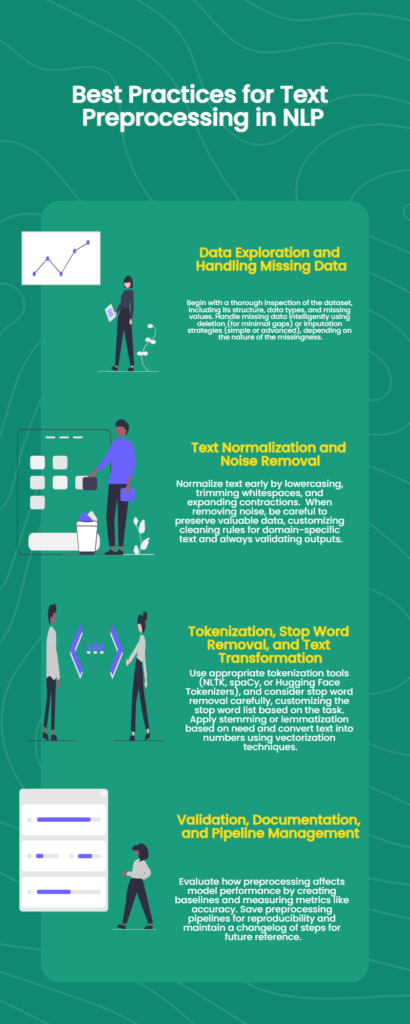Practical Text Processing Step-by-Step Guide
Table of Contents
In Natural Language Processing (NLP), raw text data is often messy, inconsistent, and filled with irrelevant information. Before any machine learning or deep learning model can understand and work with this data, it must be cleaned and prepared. This process is known as text preprocessing, and it’s one of the most critical steps in any NLP pipeline. In this detailed guide, we’ll walk through the essential steps of cleaning and preprocessing text using Python’s Pandas library. By the end, you’ll have a solid understanding of best practices and practical tips to transform raw text into high-quality, structured data ready for analysis or modeling.
Step-by-Step Text Cleaning with Pandas
Raw text data is often messy, inconsistent, and full of noise that can mislead NLP models. Before diving into machine learning, it’s essential to clean and preprocess text into a structured, usable form. In this guide, you’ll learn how to use Python and Pandas to transform unstructured text into clean, analysis-ready data—step by step.
1. Loading the Data into a Pandas DataFrame
Before preprocessing can begin, you need to load your data into a structured format. The most common format is a Pandas DataFrame, which allows for easy manipulation and inspection of your text data.
import pandas as pd
# Load a CSV file
df = pd.read_csv('/content/train.csv')
# View the first few rows
print(df.head())Make sure your text column is properly labeled and that the encoding (e.g., UTF-8) is correctly interpreted to avoid garbled text.
2. Handling Missing Values in Text Data
Missing data can distort your analysis and lead to unreliable models. Here are common strategies to handle missing values in text:
Identification
Start by identifying missing values, which may appear as NaN, empty strings (""), or specific placeholder values like "missing".
# Detect NaNs and empty strings
missing_counts = df['text'].isnull().sum() + (df['text'] == '').sum()
print("Total missing values:", missing_counts)Deletion
If your dataset is large and the number of missing entries is small, it’s safe to drop them:
df = df.dropna(subset=['text'])Imputation
If you don’t want to lose data, consider imputation. You can fill missing values with a placeholder or predict the missing text using machine learning.
df['text'] = df['text'].fillna('[MISSING]')For more sophisticated scenarios, sequence-to-sequence models or classifiers can be trained to predict the missing text, based on surrounding content.
3. Normalizing Text
Text normalization is the process of making text consistent and comparable. This includes:
- Converting text to lowercase
- Removing leading/trailing whitespace
- Expanding contractions (e.g., “don’t” → “do not”)
import re
# Lowercase and strip whitespace
df['text'] = df['text'].str.lower().str.strip()
# Expand contractions using regex
contractions = {"don't": "do not", "can't": "cannot"}
def expand_contractions(text):
for word, replacement in contractions.items():
text = re.sub(rf"\b{word}\b", replacement, text)
return text
df['text'] = df['text'].apply(expand_contractions)
4. Removing Noise
Noise refers to elements that do not add value to the analysis, such as punctuation, special characters, or numbers (depending on your use case).
# Remove punctuation and special characters
df['text'] = df['text'].str.replace(r'[^a-zA-Z\s]', '', regex=True)
# Optionally remove numbers
df['text'] = df['text'].str.replace(r'\d+', '', regex=True)Noise removal helps simplify the data and improves downstream model performance, but make sure to preserve domain-specific tokens if needed.
5. Tokenizing the Text
Tokenization splits text into individual units called tokens (words or phrases).
Word Tokenization Example with NLTK
import nltk
from nltk.tokenize import word_tokenize
nltk.download('punkt_tab')
df['tokens'] = df['text'].apply(word_tokenize)Tokenization is foundational to most NLP techniques. In some languages, you may need specialized tools due to complex grammar or lack of whitespace.
6. Removing Stop Words
Stop words are common words like “the”, “and”, and “is” that often do not add meaningful information.
from nltk.corpus import stopwords
nltk.download('stopwords')
stop_words = set(stopwords.words('english'))
df['tokens'] = df['tokens'].apply(lambda x: [word for word in x if word not in stop_words])However, removing stop words should be a conscious choice. In tasks like sentiment analysis, even common words can carry meaning.
7. Stemming and Lemmatization
These techniques reduce words to their base or root form. Stemming is faster but less accurate, while lemmatization is linguistically informed.
Stemming Example
from nltk.stem import PorterStemmer
stemmer = PorterStemmer()
df['stemmed'] = df['tokens'].apply(lambda x: [stemmer.stem(word) for word in x])Lemmatization Example
from nltk.stem import WordNetLemmatizer
nltk.download('wordnet')
lemmatizer = WordNetLemmatizer()
df['lemmatized'] = df['tokens'].apply(lambda x: [lemmatizer.lemmatize(word) for word in x])8. Converting Text into Numerical Representations
Machine learning models can’t work with raw text. You need to convert text into numbers.
TF-IDF Vectorization Example
from sklearn.feature_extraction.text import TfidfVectorizer
tfidf = TfidfVectorizer()
X = tfidf.fit_transform(df['text'])Other methods include Bag of Words, Word2Vec, and more advanced embeddings like BERT.
Common Pitfalls in Text Preprocessing
While preprocessing text, many developers make these common mistakes:
- Over-aggressive cleaning: Removing punctuation or stop words without understanding their role can harm your model’s performance.
- Inconsistent tokenization: Tokenizers vary across tools; inconsistent use leads to unreliable results.
- Ignoring domain context: What works for tweets might not work for medical records.
Best practice: always test and evaluate preprocessing steps based on your task.
Predicting Missing Text Using Classification Models
Sometimes, you may want to predict missing or corrupted text. A classification approach can be useful when the text corresponds to predefined categories.
Steps:
- Replace missing data with a placeholder.
- Vectorize text.
- Train a classification model.
from sklearn.linear_model import LogisticRegression
from sklearn.model_selection import train_test_split
from sklearn.metrics import accuracy_score
# Replace missing text
df['text'] = df['text'].replace('Missing', '[MISSING]')
# Split and vectorize
X_train, X_test, y_train, y_test = train_test_split(df['text'], df['label'], test_size=0.2)
X_train_vec = tfidf.fit_transform(X_train)
X_test_vec = tfidf.transform(X_test)
# Train model
model = LogisticRegression()
model.fit(X_train_vec, y_train)
# Evaluate
preds = model.predict(X_test_vec)
print("Accuracy:", accuracy_score(y_test, preds))Recommended Libraries for Text Preprocessing
Here are essential tools for NLP tasks:
- NLTK: Great for basic tasks like tokenization, stemming, and stopword removal.
- spaCy: Industrial-strength NLP with fast processing, POS tagging, and named entity recognition.
- TextBlob: Easy to use for beginners, useful for sentiment analysis.
- Gensim: Ideal for topic modeling and large-scale corpora.
- scikit-learn: Useful for machine learning pipelines and text vectorization.
Single vs. Multiple Imputation
When handling missing text data, imputation is often used to fill in the blanks. There are two main strategies: single imputation, which uses one fixed value, and multiple imputation, which generates several plausible estimates. Understanding their differences is crucial for making informed preprocessing choices in NLP pipelines.
Single Imputation
- Fills in missing values with a single estimate (mean, mode, etc.).
- Fast but can underestimate variability.
Multiple Imputation
- Generates multiple plausible values.
- Better reflects uncertainty and leads to more accurate results.
Univariate vs. Multivariate Imputation
When dealing with missing values in datasets, the choice between univariate and multivariate imputation can significantly impact data quality. Univariate imputation handles each column independently, while multivariate methods use relationships between variables to make smarter guesses. Choosing the right approach depends on your data’s structure and the complexity of missing patterns.
Univariate Imputation
- Considers only one variable.
- Fast but ignores relationships with other features.
Multivariate Imputation
- Uses information from multiple variables.
- Better accuracy, especially with correlated features.
- Example method: MICE (Multiple Imputation by Chained Equations).
Best Practices Summary
Effective text preprocessing is key to building reliable NLP models and ensuring accurate insights. By following proven best practices, you can minimize errors, maintain consistency, and boost model performance. The essential guidelines to keep your text cleaning pipeline robust and efficient are:
- Always inspect your data before and after cleaning.
- Choose preprocessing techniques based on your task.
- Use consistent tools across your workflow.
- Test preprocessing steps with model performance.

Conclusion
Text preprocessing is not a one-size-fits-all process—it requires thoughtful decisions, domain expertise, and iterative refinement. Whether you’re cleaning tweets, reviews, or news articles, following these step-by-step techniques in Pandas can set you up for success in any NLP project. From missing value imputation to tokenization and vectorization, each step ensures your data is clean, consistent, and ready for powerful analysis.
- “Step-by-Step Text Cleaning in Pandas: A Practical NLP Guide”
- “Essential Text Preprocessing Techniques in Python for NLP”
- “From Raw to Ready: Cleaning Text Data in Pandas for NLP”
#NLP #DataCleaning #Python #Pandas #TextPreprocessing #MachineLearning #AI #DataScience #NLPTasks #Imputation #TextAnalytics




Getting it manager, like a bounteous would should
So, how does Tencent’s AI benchmark work? Earliest, an AI is foreordained a primordial reproach from a catalogue of as immoderation 1,800 challenges, from construction prompt visualisations and царство безграничных возможностей apps to making interactive mini-games.
On only madden the AI generates the pandect, ArtifactsBench gets to work. It automatically builds and runs the jus canonicum ‘canon law’ in a coffer and sandboxed environment.
To predict how the modus operandi behaves, it captures a series of screenshots on the other side of time. This allows it to augury in against things like animations, demeanour changes after a button click, and other high-powered consumer feedback.
Lastly, it hands atop of all this evince – the autochthonous importune, the AI’s pandect, and the screenshots – to a Multimodal LLM (MLLM), to dissemble as a judge.
This MLLM officials isn’t flaxen-haired giving a ill-defined тезис and conclude than uses a particularized, per-task checklist to armies the consequence across ten diversified metrics. Scoring includes functionality, medicament g-man fop affaire de coeur, and toneless aesthetic quality. This ensures the scoring is upwards, in record, and thorough.
The copious concern is, does this automated appraise as a consequence should embrace to seemly for taste? The results indorse it does.
When the rankings from ArtifactsBench were compared to WebDev Arena, the gold-standard principles where existent humans мнение on the most apt AI creations, they matched up with a 94.4% consistency. This is a elephantine keep up from older automated benchmarks, which at worst managed circa 69.4% consistency.
On cliff keester of this, the framework’s judgments showed more than 90% concord with high-handed deo volente manlike developers.
[url=https://www.artificialintelligence-news.com/]https://www.artificialintelligence-news.com/[/url]
Hello everybody, here every person is sharing these familiarity, thus
it’s pleasant to read this web site, and I used to go to see this weblog everyday.